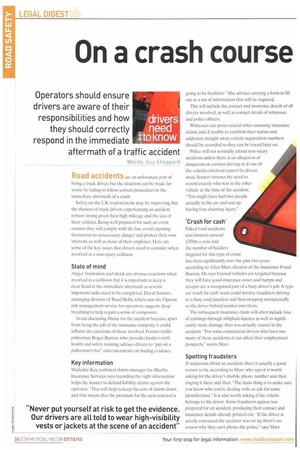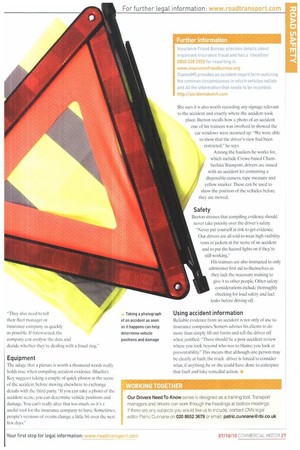On a crash course
Page 26

Page 27

If you've noticed an error in this article please click here to report it so we can fix it.
Operators should ensure drivers are aware of their responsibilities and how they should correctly respond in the immediate aftermath of a traffic accident
WOWS: 6uy 1.ileppard Road accidents are an unfotunate part of being a truck driver, but the situation can he made far worse by failing to follow correct procedures in the immediate aftermath of a crash.
Safety on the UK road network may be improving, but the chances of truck drivers experiencing an accident remain strong given their high mileage and the size of their vehicles. Being well prepared for such an event ensures they will comply with the law, avoid exposing themselves to unnecessary danger and protect their own interests, as well as those of their employer. Here are some of the key issues that drivers need to consider when involved in a non-injury collision.
State of mind
Anger, frustration and shock are obvious reactions when involved in a collision, but it is important to keep a clear head in the immediate aftermath as several important tasks need to be completed. David Somers, managing director of Road Skills, which runs the Opcom risk management service for operators, suggests deep breathing to help regain a sense of composure.
Avoid discussing blame for the accident because, apart from being the job of the insurance company, it could inflame the emotions of those involved. Former traffic policeman Roger Burton. who provides hauliers with health and safety training, advises drivers to "put on a policeman's hat" and concentrate on finding evidence.
Key information
Madeline Key, technical claims manager for Bluefin Insurance Services, says recording the right information helps the insurer to defend liability claims against the operator. "That will help to keep the cost of claims down and that means that the premium for the next renewal is going to be healthier." She advises carrying a form to fill out or a list of information that will be required.
This will include the contact and insurance details of all drivers involved, as well as contact details of witnesses and police officers.
Witnesses can prove crucial when assessing insurance claims and, if unable to establish their names and addresses straight away, vehicle registration numbers should be recorded so they can be traced later on.
Police will not normally attend non-injury accidents unless there is an allegation of dangerous or careless driving or if one of the vehicles involved cannot be driven away. Somers stresses the need to record exactly who was in the other vehicle at the time of the accident. "You might have had two people actually in the car and end up having four claiming injury.
'Crash for cash'
Faked road accidents cost insurers around £350m a year and the number of hauliers targeted for this type of crime has risen significantly over the past two years, according to Glen Marr, director of the Insurance Fraud Bureau. He says liveried vehicles are targeted because they will have good insurance cover and bumps and scrapes are a recognised part of a busy driver's job. A typical 'crash for cash' scam could involve fraudsters driving to a busy road junction and then stopping unexpectedly so the driver behind crashes into them.
The subsequent insurance claim will often include loss of earnings through whiplash injuries as well as significantly more damage than was actually caused in the accident. "For some commercial drivers who have too many of these accidents, it can affect their employment prospects," warns Marr.
Spotting fraudsters
If suspicious about an accident, there is usually a good reason to be, according to Marr, who says it is worth asking for the driver's mobile phone number and then ringing it there and then. "The main thing is to make sure you know who you're dealing with, so ask for some identification.It is also worth asking if the vehicle belongs to the driver. Some fraudsters appear too prepared for an accident, producing their contact and insurance details already printed out. "If the driver is utterly convinced the accident was set up, there's no reason why they can't phone the police," says Marr.
"They also need to tell their fleet manager or insurance company as quickly as possible. If forewarned, the company can analyse the data and
decide whether they're dealing with a fraud ring:
Equipment
The adage that a picture is worth a thousand words really holds true when compiling accident evidence. Bluefin's Key suggests taking a couple of quick photos at the scene of the accident before moving elsewhere to exchange details with the third party. "If you can take a photo of the accident scene, you can determine vehicle positions and damage. You can't really alter that too much. so it's a useful tool for the insurance company to have. Sometimes, people's versions of events change a little bit over the next few days." She says it is also worth recording any signage relevant to the accident and exactly where the accident took place. Burton recalls how a photo of an accident one of his trainees was involved in showed the car windows were steamed up. "We were able to show that the driver's view had heen restricted," he says.
Among the hauliers he works for, which include Crewe-based Chamberlain Transport, drivers are issued with an accident kit containing a disposable camera, tape measure and yellow marker. These can he used to show the position of the vehicles before they are moved.
Safety
Burton stresses that compiling evidence should never take priority over the driver's safety. "Never put yourself at risk to get evidence.
Our drivers are all told to wear high-visibility vests or jackets at the scene of an accident and to put the hazard lights on if they're still working."
His trainees are also instructed to only administer first aid to themselves as they lack the necessary training to give it to other people. Other safety considerations include thoroughly checking for load safety and fuel leaks before driving off
Using accident information
Reliable evidence from an accident is not only of use to insurance companies. Somers advises his clients to do more than simply fill out forms and tell the driver off when justified. "There should be a post-accident review where you look beyond who was to blame; you look at preventability."This means that although one person may be clearly at fault, the truck driver is forced to consider what, if anything, he or she could have done to anticipate that fault and take remedial action.




























































































































